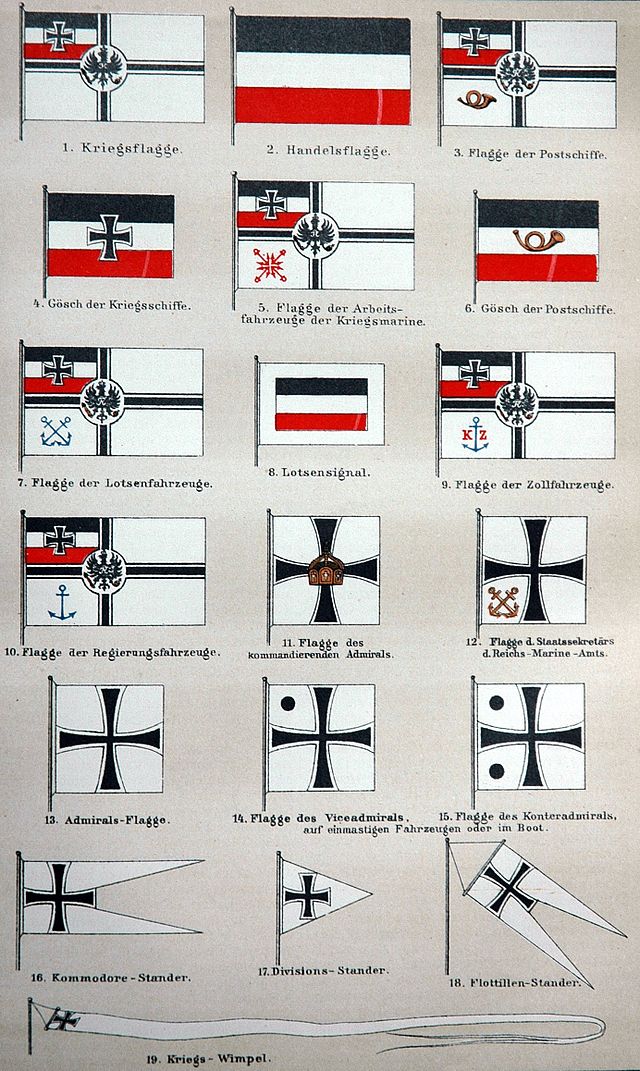Flag of the German Empire
From Wikipedia, the free encyclopedia
The black-white-red flag[1] (Schwarz-Weiß-Rot),[2] also known as the flag of the German Empire, the Imperial Flag (Kaiserflagge) or the Realm Flag (Reichsflagge), is a combination between the flag of Prussia and the flag of the Hanseatic League. Starting as the national flag of the North German Confederation, it would go on to be commonly used officially and unofficially under the nation-state of the German Reich, which existed from 1871 to 1945. After 1918, it was used as a political symbol by various organizations.
You can help expand this article with text translated from the corresponding article in German. (May 2022) Click [show] for important translation instructions.
|
 | |
| Use | State flag, civil and state ensign |
|---|---|
| Proportion | 2:3 (3:5 in 1933–1935) |
| Adopted |
|
| Relinquished |
|
| Design | A horizontal tricolour of black, white, and red |
History
Summarize
Perspective
Unification of Germany
The flag was first proposed and adopted under the leadership of Otto von Bismarck, where it would be used as the flag of the North German Confederation which was formed in 1867.[3] During the Franco-Prussian War, the German Empire was founded (i.e., the South German states joined the Confederation). Germany would continue using it until the German Revolution of 1918–1919, which resulted in the founding of the Weimar Republic.[4]
Weimar Republic and Nazi Germany

The Weimar Republic did not use it as a national flag though it did see use within the Reichswehr and by many paramilitary organizations including the Freikorps.[5] It would see usage by right-wing conservative and liberal political parties, including the German National People's Party and the German People's Party. Immediately after the electoral victory of the Nazi Party in March 1933, German President Paul von Hindenburg reinstated the black-white-red flag by decree as the national flag of Germany. It is worth noting, however, that the swastika flag of the Nazi Party was to be flown along with this flag.[6] In September 1935, a year after Hindenburg's death and Adolf Hitler's elevation to the rank of Führer, the swastika flag became the national flag of Germany;[7] the old imperial flag was deemed "reactionary", and banned.[8]
World War II

During World War II, German prisoners of war who had defected to the Soviet Union and German exiles in the Soviet Union, mainly the members of the Communist Party of Germany, formed the National Committee for a Free Germany, an anti-fascist military and political organization which sought to overthrow the Nazi regime and aided the Red Army in various ways, including the combat against the Wehrmacht, and adopted the black-white red flag as their symbol and as a flag for a possible democratic German state after the overthrow of Hitler. The main reason for the choice was the rejection of the Weimar Republic by the organization, since the prisoners of war who constituted the majority of the organization were highly critical of the Weimar Germany and said that initially they supported the Nazis only because of their disgust or hatred towards the "weakness" of the Weimar Republic, and the Communists agreed with them. The manifesto of the organization included criticisms of the "powerless" Weimar Republic and contrasted it to the future democratic state, a "truly popular" democratic government strong enough to crush the remains of the Nazi regime. The other reason was that the KPD leaders wanted to reassure its majority that the NKFD was not a Communist outfit but a union with all kind of views opposed to Nazism. The black-white-red flag became the flag of the organization and was used in its propaganda materials and on the armbands worn by the members of the organization.[9]
Many members of this organization would play a role in the Soviet occupation and organization of the East German government. Due to this, the Imperial Flag was proposed as a national flag for East Germany by those who saw it as a symbol of German resistance to Nazism and by those who saw the black-red-gold tricolor as a symbol of the failed Weimar Republic. However, the East German government ultimately adopted the black-red-gold flag, later adding the country's coat of arms to distinguish it from the otherwise identical West German flag.[10][11]
After German Reunification

After the reunification of Germany, the Reichsflagge remained as a symbol among right-wing monarchist organizations and the far-right in Germany. Due to the ban on Nazi swastika flag in modern Germany, many German Neo-Nazis instead adopted the Imperial Flag. However, the flag never originally had any racist or anti-Semitic meaning, despite its brief use in Nazi Germany. Among the right-wing the flag typically represents a rejection of the Federal Republic.[12][13]
Gallery
War ensigns and jacks

- War Ensign of Germany (1867–1892)
- War Ensign of Germany (1903–1919)
- War Ensign of Germany (1903–1919) - Variant
- Proposed war ensign (1919-1921) - never officially used
- War Ensign of Germany (1921–1933)
- Jack of North German Confederation and German Empire (1866–1903)
- Jack of North German Confederation and German Empire (1866–1903) - 3:5 Variant
National flags
- Flag of the North German Confederation and German Empire (1867–1918)
- Flag of Nazi Germany (1933–1935)
Service flags and other
- Flag of the Imperial Colonial Office (1907–1919)
- Command symbol of the supreme commander in China (1900–1901)
- Service flag of the Reich authorities at sea (1921–1926)
- Service Flag of the Reich (1933–1935)
- Reich service flag of the Imperial Navy
- Flag of the mail ships (German Empire, 1892–1918)
- Service flag for the “Other administrative branches of the Reich”, (1893–1919)
- Merchant flag of the German Empire with the Iron Cross, (1896–1918)
Groups that use the Imperial flag
Historical
Modern day
- National Democratic Party of Germany
- Reichsbürger movement
- Several neo-Nazi groups and parties
See also
References
Wikiwand - on
Seamless Wikipedia browsing. On steroids.

















